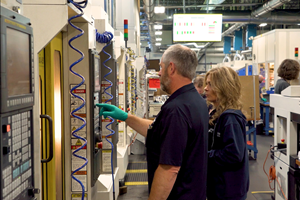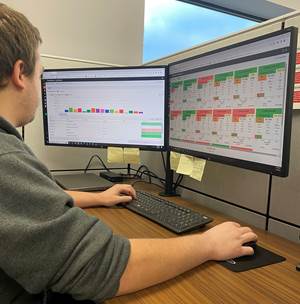Machine Monitoring Is the First Step to Data-Driven Manufacturing and Industry 4.0
Before automating or digitalizing production, a company should streamline existing processes by setting up a machine-monitoring system.
Share





Before implementing any production automation and digitalization project, a company should streamline existing processes. This step focuses on identifying and eliminating bottlenecks in the work flows to ensure efficient operation of all subsystems. The main actions are to collect accurate, up-to-date information about all events that occur during operation and deliver it to responsible persons. Otherwise, the result of automating or digitalizing may simply result in less order, not more, in the work flow. Therefore, the first phase in creating a “factory of tomorrow” is setting up a machine-data-collection (MDC) system or, simply, a machine-monitoring system. If skillfully deployed, a machine-monitoring system can provide significant opportunities for a company to reduce costs, increase productivity and improve its bottom line.
The main purpose of monitoring systems is to track equipment operation and increase its efficiency. The principles behind effective machine monitoring can be seen using Zyfra’s MCDplus monitoring system as an example. Although Zyfra, a software developer headquartered in Finland, is a newcomer to the U.S. market, the company has more than 200 overseas customers who have connected 6,000-plus machines to its systems for real-time monitoring.
Like most such systems, its implementation is rather simple. Drivers can be installed in modern CNC machines to provide detailed information on the changes in the machines’ status. Legacy equipment is fitted with monitoring terminals and adapters connected to the CNC or the machine’s relay-ladder logic system. These hardware and software agents collect information on the machine’s operation and operator’s actions: running hours, downtime, downtime reason, which operator was on duty during downtime and so on. All such data is sent to the server, where the software analyzes the data received and presents it to users in a convenient, understandable form. These reports provide managers with information they can use to make better decisions and improve machine performance. Management control is usually achieved on three levels.
The first level is the creation of conditions for the most effective equipment utilization. For example, MCDplus enables the objective evaluation of the actual equipment load, which in turn enables process engineers and schedulers to identify bottlenecks in the process flow: loss of working hours, waste of production resources, excessive setup or change-over time, and so on. This information will assist in making decisions related to removing obstructions that interfere with the smooth flow of production processes as well as increase the machinery utilization ratio. The techniques of lean manufacturing can be applied more effectively to the value stream, for example. Additionally, these actions improve discipline at workstations, reduce energy losses and optimize operation of service departments.
The second level is related to control of production processes for greater efficiency. Managers can relate machine time to specific operations and determine if better CNC programming techniques, upgraded cutting tools, on-machine probing or other changes will improve overall performance. Typically (using results from the MCDplus monitoring system as an example), the result is an 8- to 12-percent improvement. The overall-equipment-effectiveness (OEE) value is also calculated at this stage.
The third level is downtime and computerized maintenance management. Two issues are resolved at this level: The first is a timely and efficient dispatching of service departments, and the second is efficient maintenance and repair (M&R) of operations—a certainty that the right problem is fixed the right way at the right time. For example, MCDplus automatically registers each unplanned downtime case. The system classifies it by operator, followed by the appropriate notification being sent to the service department responsible for this type of incident. All activities are reflected in reports that enable management to assess quickly the work done and, if necessary, thoroughly analyze any specific case or fine-tune responses for subsequent, similar cases. As a result, unplanned equipment downtime goes down while proactive maintenance helps equipment service life go up.
Experience shows that intelligent M&R dispatching and modern planning methods can reduce unplanned downtime by 10 to 15 percent in many shops.
Excessive power consumption is another problem that can be addressed effectively by monitoring systems. Charges for electricity used in machining operations are among the factors that exert a strong influence on production costs. Thanks to the ability to track machine operation in real time, the monitoring system enables managers to identify electricity costs for each machine and employee as well as detect the causes of energy losses. These insights facilitate precise power-consumption planning and optimization of equipment energy usage. Actual and planned electricity costs per unit can be compared, thus simplifying decision-making to minimize costs based on the accumulated data. For example, it is possible to schedule operations shown to be “energy hogs” for times when utility rates are low such as at nighttime hours.
MDC system functionality and the collected data can be used to resolve a wide range of production-management issues. Dynamic analytics enable company managers or heads of specific production departments to assess quickly key performance indicators (KPIs) overall, as well as KPIs for any individual workshop, CNC machine or particular operator. Changes can be tracked over time to identify trends and causes of these changes, and to take timely corrective actions.
In short, machine monitoring will propel a company to a new level of efficiency and bring it one step closer to making the fourth industrial revolution (based on digitalization and data-driven manufacturing) a practical reality.
Related Content
Shop Quotes Smarter, Works Harder with Machine Monitoring
Temco first installed MT-LINKi to optimize quoting. Now, the software helps the shop optimize its machines — and machine purchases.
Read MoreMachine Monitoring Boosts Aerospace Manufacturer's Utilization
Once it had a bird’s eye view of various data points across its shops, this aerospace manufacturer raised its utilization by 27% in nine months.
Read MoreSwiss-Type Control Uses CNC Data to Improve Efficiency
Advanced controls for Swiss-type CNC lathes uses machine data to prevent tool collisions, saving setup time and scrap costs.
Read MoreFour Questions (& Answers) About Data-Driven Process Improvement at CNC Job Shops
How can shops can make informed decisions using data-driven feedback to improve shopfloor efficiency and profitability? And how will these technologies differ between high- and low-volume production?
Read MoreRead Next
Building Out a Foundation for Student Machinists
Autodesk and Haas have teamed up to produce an introductory course for students that covers the basics of CAD, CAM and CNC while providing them with a portfolio part.
Read MoreRegistration Now Open for the Precision Machining Technology Show (PMTS) 2025
The precision machining industry’s premier event returns to Cleveland, OH, April 1-3.
Read MoreSetting Up the Building Blocks for a Digital Factory
Woodward Inc. spent over a year developing an API to connect machines to its digital factory. Caron Engineering’s MiConnect has cut most of this process while also granting the shop greater access to machine information.
Read More


















.jpg;maxWidth=300;quality=90)










